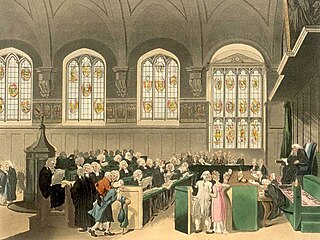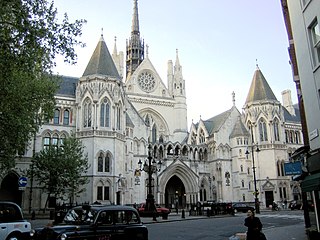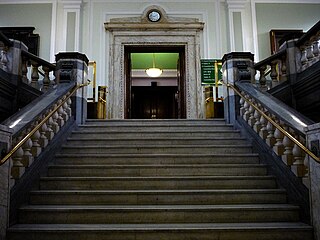
A trust is a legal relationship in which the owner of property, or any transferable right, gives it to another to manage and use solely for the benefit of a designated person. In the English common law, the party who entrusts the property is known as the "settlor", the party to whom it is entrusted is known as the "trustee", the party for whose benefit the property is entrusted is known as the "beneficiary", and the entrusted property is known as the "corpus" or "trust property". A testamentary trust is an irrevocable trust established and funded pursuant to the terms of a deceased person's will. An inter vivos trust is a trust created during the settlor's life.

Maxims of equity are legal maxims that serve as a set of general principles or rules which are said to govern the way in which equity operates. They tend to illustrate the qualities of equity, in contrast to the common law, as a more flexible, responsive approach to the needs of the individual, inclined to take into account the parties' conduct and worthiness. They were developed by the English Court of Chancery and other courts that administer equity jurisdiction, including the law of trusts. Although the most fundamental and time honored of the maxims, listed on this page, are often referred to on their own as the 'maxims of equity' or 'the equitable maxims', it cannot be said that there is a definitive list of them. Like other kinds of legal maxims or principles, they were originally, and sometimes still are, expressed in Latin.
A resulting trust is an implied trust that comes into existence by operation of law, where property is transferred to someone who pays nothing for it; and then is implied to hold the property for the benefit of another person.

In trust law, a constructive trust is an equitable remedy imposed by a court to benefit a party that has been wrongfully deprived of its rights due to either a person obtaining or holding a legal property right which they should not possess due to unjust enrichment or interference, or due to a breach of fiduciary duty, which is intercausative with unjust enrichment and/or property interference. It is a type of implied trust.

English trust law concerns the protection of assets, usually when they are held by one party for another's benefit. Trusts were a creation of the English law of property and obligations, and share a subsequent history with countries across the Commonwealth and the United States. Trusts developed when claimants in property disputes were dissatisfied with the common law courts and petitioned the King for a just and equitable result. On the King's behalf, the Lord Chancellor developed a parallel justice system in the Court of Chancery, commonly referred as equity. Historically, trusts have mostly been used where people have left money in a will, or created family settlements, charities, or some types of business venture. After the Judicature Act 1873, England's courts of equity and common law were merged, and equitable principles took precedence. Today, trusts play an important role in financial investment, especially in unit trusts and in pension trusts. Although people are generally free to set the terms of trusts in any way they like, there is a growing body of legislation to protect beneficiaries or regulate the trust relationship, including the Trustee Act 1925, Trustee Investments Act 1961, Recognition of Trusts Act 1987, Financial Services and Markets Act 2000, Trustee Act 2000, Pensions Act 1995, Pensions Act 2004 and Charities Act 2011.
The three certainties compose a rule within English trusts law on the creation of express trusts that, to be valid, the trust instrument must show certainty of intention, subject matter and object. "Certainty of intention" means that it must be clear that the donor or testator wishes to create a trust; this is not dependent on any particular language used, and a trust can be created without the word "trust" being used, or even the donor knowing he is creating a trust. Since the 1950s, the courts have been more willing to conclude that there was intention to create a trust, rather than hold that the trust is void. "Certainty of subject matter" means that it must be clear what property is part of the trust. Historically the property must have been segregated from non-trust property; more recently, the courts have drawn a line between tangible and intangible assets, holding that with intangible assets there is not always a need for segregation. "Certainty of objects" means that it must be clear who the beneficiaries, or objects, are. The test for determining this differs depending on the type of trust; it can be that all beneficiaries must be individually identified, or that the trustees must be able to say with certainty, if a claimant comes before them whether; they are or are not a beneficiary.

Twinsectra Ltd v Yardley[2002] UKHL 12 is a leading case in English trusts law. It provides authoritative rulings in the areas of Quistclose trusts and dishonest assistance.

Re Vandervell Trustees Ltd [1974] EWCA Civ 7 is a leading English trusts law case, concerning resulting trusts.

Charitable trusts in English law are a form of express trust dedicated to charitable goals. There are various advantages to charitable trust status, including exemption from most forms of tax and freedom for the trustees not found in other types of English trusts. To be a valid charitable trust, the organization must demonstrate both a charitable purpose and a public benefit. Applicable charitable purposes are normally divided into categories for public benefit, including the relief of poverty, the promotion of education, the advancement of health and saving of lives, the promotion of religion, and all other types of trusts recognized by the law. There is also a requirement that the trust's purposes benefit the public, and not simply a group of private individuals.
The creation of express trusts in English law must involve four elements for the trust to be valid: capacity, certainty, constitution and formality. Capacity refers to the settlor's ability to create a trust in the first place; generally speaking, anyone capable of holding property can create a trust. There are exceptions for statutory bodies and corporations, and minors who usually cannot hold property can, in some circumstances, create trusts. Certainty refers to the three certainties required for a trust to be valid. The trust instrument must show certainty of intention to create a trust, certainty of what the subject matter of the trust is, and certainty of who the beneficiaries are. Where there is uncertainty for whatever reason, the trust will fail, although the courts have developed ways around this. Constitution means that for the trust to be valid, the property must have been transferred from the settlor to the trustees.
In English law, secret trusts are a class of trust defined as an arrangement between a testator and a trustee, made to come into force after death, that aims to benefit a person without having been written in a formal will. The property is given to the trustee in the will, and he would then be expected to pass it on to the real beneficiary. For these to be valid, the person seeking to enforce the trust must prove that the testator intended to form a trust, that this intention was communicated to the trustee, and that the trustee accepted his office. There are two types of secret trust — fully secret and half-secret. A fully secret trust is one with no mention in the will whatsoever. In the case of a half-secret trust, the face of the will names the trustee as trustee, but does not give the trust's terms, including the beneficiary. The most important difference lies in communication of the trust: the terms of a half-secret trust must be communicated to the trustee before the execution of the will, whereas in the case of a fully secret trust the terms may be communicated after the execution of the will, as long as this is before the testator's death.
Constructive trusts in English law are a form of trust created by the English law courts primarily where the defendant has dealt with property in an "unconscionable manner"—but also in other circumstances. The property is held in "constructive trust" for the harmed party, obliging the defendant to look after it. The main factors that lead to a constructive trust are unconscionable dealings with property, profits from unlawful acts, and unauthorised profits by a fiduciary. Where the owner of a property deals with it in a way that denies or impedes the rights of some other person over that property, the courts may order that owner to hold it in constructive trust. Where someone profits from unlawful acts, such as murder, fraud, or bribery, these profits may also be held in constructive trust. The most common of these is bribery, which requires that the person be in a fiduciary office. Certain offices, such as those of trustee and company director, are always fiduciary offices. Courts may recognise others where the circumstances demand it. Where someone in a fiduciary office makes profits from their duties without the authorisation of that office's beneficiaries, a constructive trust may be imposed on those profits; there is a defence where the beneficiaries have authorised such profits. The justification here is that a person in such an office must avoid conflicts of interest, and be held to account should he fail to do so.
A Quistclose trust is a trust created where a creditor has lent money to a debtor for a particular purpose. If the debtor uses the money for any other purpose, then it is held on trust for the creditor. Any inappropriately spent money can then be traced, and returned to the creditors. The name and trust comes from the House of Lords decision in Barclays Bank Ltd v Quistclose Investments Ltd (1970), although the underlying principles can be traced back further.
Tracing is a procedure in English law used to identify property which has been taken from the claimant involuntarily or which the claimant wishes to recover. It is not in itself a way to recover the property, but rather to identify it so that the courts can decide what remedy to apply. The procedure is used in several situations, broadly demarcated by whether the property has been transferred because of theft, breach of trust, or mistake.
Discretionary trusts and powers in English law are elements of the English law of trusts, specifically of express trusts. Express trusts are trusts expressly declared by the settlor; normally this is intended, although there are situations where the settlor's intentions create a trust accidentally. Normal express trusts are described as "fixed" trusts; the trustees are obliged to distribute property, with no discretion, to the fixed number of beneficiaries. Discretionary trusts, however, are where the trustee has discretion over his actions, although he is obliged to act. The advantages of discretionary trusts are that they provide flexibility, and that the beneficiaries hold no claim to the property; as such, they cannot seek to control it, and it cannot be claimed for their debts. A power, or "mere power", on the other hand, is where not only does the holder have discretion over his actions, he has discretion over whether to act in the first place.

Westdeutsche Landesbank Girozentrale v Islington LBC[1996] UKHL 12, [1996] AC 669 is a leading English trusts law case concerning the circumstances under which a resulting trust arises. It held that such a trust must be intended, or must be able to be presumed to have been intended. In the view of the majority of the House of Lords, presumed intention to reflect what is conscionable underlies all resulting and constructive trusts.

Tinsley v Milligan[1993] UKHL 3 is an English trusts law case, concerning resulting trusts, the presumption of advancement and illegality.

Air Jamaica Ltd v Charlton [1999], UKPC 20, is an English trusts law case concerning resulting trusts. In this case, Lord Millett expressed the view that a resulting trust arises due to the absence of intention to benefit a recipient of money.

Pennington v Waine[2002] EWCA Civ 227 is an English trusts law case, concerning the requirements for a trust to be properly constituted, and the operation of constructive trusts. The case represents an equitable exception to the need for a complete transfer of property in law.
Undue influence in English law is a field of contract law and property law whereby a transaction may be set aside if it was procured by the influence exerted by one person on another, such that the transaction "ought not fairly to be as treated the expression of [that] person's free will".










